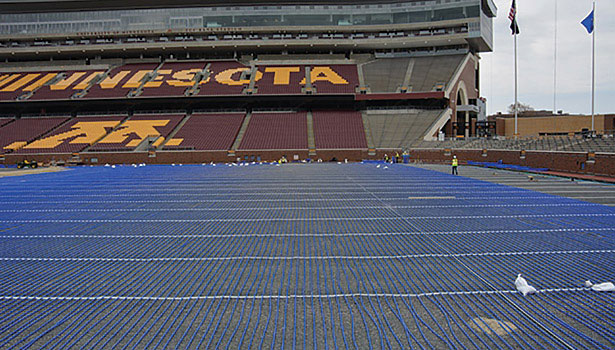Cold weather and football just seem to go together, but frozen fields have a tendency to draw complaints, especially from NFL players who know that a frozen field is akin to a slab of concrete. That put the Minnesota Vikings between a rock and a hard place when it came to relocating to TCF Bank Stadium (home of the University of Minnesota Golden Gophers) for the 2014 and 2015 NFL seasons.
Some changes were required before the stadium was ready for NFL play — among them was the installation of a new hydronic heating system, complete with 38 miles of Aquatherm Blue Pipe®, to keep the turf field from freezing.
The process of choosing the material for the new system was a collaborative process between Vikings management, the University of Minnesota, and a host of engineering and installation professionals.
“At that level of the game, clients tend to use what they’ve used before,” said Brian Storm, president and CEO of Fields Inc., the firm the Vikings chose to oversee renovations to the TCF field.
Storm, whose firm has been involved in the installation of field heating systems for the Philadelphia Eagles, Denver Broncos, and Green Bay Packers, was introduced to Aquatherm during the design process of the TCF renovation.
“As we took a closer look, we began to see that [Aquatherm] could meet and even exceed some of the interesting challenges of this project,” Storm explained.
One of the main obstacles was the substrate beneath the field: while most heated synthetic fields use sand as a base, TCF had 12-18 in of aggregate. Since the void between the particles creates a pathway for heat loss, pipes would have to be installed closer to the field surface and carry fluid at a higher temperature than what many other thermoplastic systems could handle. Aquatherm Blue Pipe® is safe to use in applications between to -5°F and 200°F (depending on pressure rating).
Thanks to Aquatherm pipe’s heat fusion connections, around 4,000 mechanical joints that would have been buried were eliminated. The heat fusion process bonds the polypropylene pipe and fitting at the molecular level, making each connection as strong as the pipe itself. This allowed workers to transform several hundred sections of pipe and thousands of fittings and manifolds into one seamless fluid transport system.
But of all the benefits Aquatherm brought to this project, the warranty was the most compelling. When installed by factory-certified installers, Aquatherm piping systems come with a 10-yr, multi-million dollar warranty that covers not only material replacement but also property damage, personal injury, and loss of use of the facility.
“We’d never had anyone offer that to us before. It was the nail in the coffin when it came to making this decision,” said Storm.
Given the tight schedule and complexity of the system, the installers with mechanical contractor Harris Mechanical were fortunate to use a single pipe material for the entire system, from the 8-in hot water supply pipe to the .50-in nominal (20 mm) tubing installed in the field. Traditional thermoplastics were not available in such large sizes and would have required various transitional points between piping materials.
In order to keep the field above freezing during games and practice, a 50/50 mixture of DOWFROST™ glycol is heated and pumped throughout the piping system, which is laid out on 6-in centers. The temperature of the DOWFROST mixture is adjusted according to the coldest reading from Johnson Controls temperature sensors placed throughout the field to maintain a sub-base temperature of 40°F — just enough heat to prevent the field from freezing.
Bell & Gossett shell-and-tube heat exchangers serve as the heat source for the field. Steam coming from the central plant is pulled off of the campus loop and reduced to 10 psi before entering the shell of the heat exchangers. The system uses roughly 7,000 gal of DOWFROST and is designed to deliver approximately 10-MM/Btu at design conditions, delivering 120°F water to the field via Bell & Gossett Series 1510 pumps with ABB VFDs. The heat exchangers are installed with 100% redundancy.
As the 2014 season got underway, the Vikings were able to focus on football and not whether their field would be frozen solid. Meanwhile, everyone who partnered on the project was able to relax, knowing that NFL football will continue uninterrupted in Minnesota until the new indoor Vikings Stadium opens in 2016.




